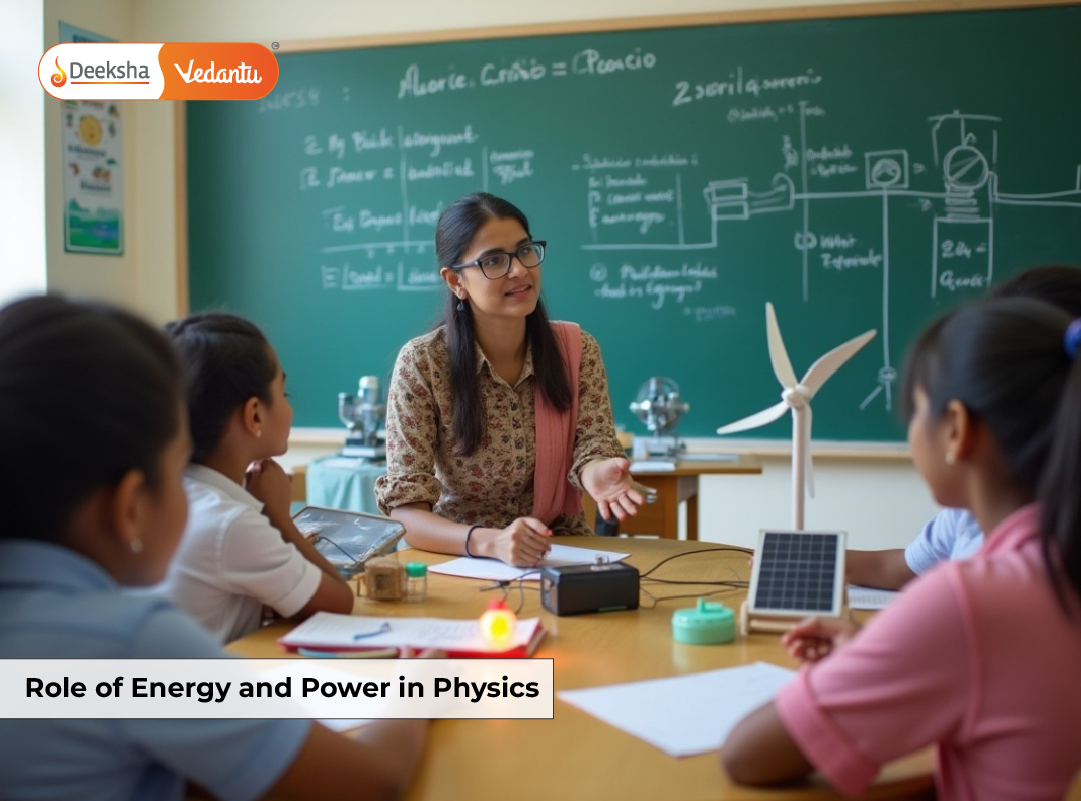Introduction
Energy and power are fundamental concepts in physics that influence everything from how machines function to how we perform everyday activities. Whether it’s the electricity that powers your home, the food you consume for biological energy, or the sun fueling the Earth, energy and power play crucial roles across various domains.
Understanding these concepts is especially important for school students, as they form the foundation for more advanced topics in science and engineering. They also appear frequently in academic examinations and real-world applications.
In this blog, we will explore the key differences between energy and power, understand various types of energy, and examine how these principles are applied in real-life scenarios with in-depth examples and explanations.
What Is Energy?
Energy is defined as the capacity to do work. It exists in various forms and can neither be created nor destroyed—only transformed from one form to another, as stated by the Law of Conservation of Energy. This principle is one of the cornerstones of classical physics and explains why energy is a crucial subject of study.
Energy enables change. For instance, when you lift a heavy object, your body expends energy to overcome gravitational force. Similarly, when gasoline burns in a car engine, chemical energy is transformed into mechanical energy that drives the vehicle.
Types of Energy
- Kinetic Energy: Energy of a moving object. A car speeding down a highway, a cricket ball thrown by a bowler, or even air molecules in motion all possess kinetic energy.
- Potential Energy: Stored energy due to position. A stretched rubber band, a compressed spring, or water held behind a dam has the potential to perform work.
- Thermal Energy: Associated with heat and the motion of particles in a substance. When you boil water, thermal energy causes water molecules to move faster and eventually change state.
- Chemical Energy: Stored in molecular bonds, this type of energy is released during chemical reactions. It powers everything from batteries to our own bodies.
- Electrical Energy: Generated by the movement of electrons. It’s used to operate appliances, run motors, and power cities.
- Nuclear Energy: Found in the nucleus of atoms and released during fission or fusion reactions. Nuclear reactors and the sun are primary sources.
- Sound and Light Energy: Sound travels in longitudinal waves, while light travels in electromagnetic waves. Both play vital roles in communication, vision, and many technologies.
Each form of energy can be converted into another. For example, solar panels convert light energy into electrical energy.
Explore more: Types of Energy
What Is Power?
Power measures how quickly work is done or how fast energy is transferred. It is an essential quantity in understanding the performance of machines and systems.
If two people climb the same staircase, but one does it in half the time, the one who climbs faster uses more power, even if the energy expended is the same.
Power Formula in Physics
or
This formula helps us determine how rapidly work is completed. A high-power machine can do more work in less time compared to a low-power one.
SI Unit
- Power: Watt (W)
- 1 Watt = 1 Joule/second
Larger units include kilowatt (kW) and megawatt (MW), often used in electrical engineering and energy management.
Check out: Electric Power
Difference Between Energy and Power
Though closely related, energy and power serve different functions. Energy refers to the ability to perform work, while power tells us how fast that energy is used.
| Feature | Energy | Power |
| Definition | Capacity to do work | Rate of doing work |
| Unit | Joule (J) | Watt (W) |
| Measurement | Total work done | Work done per unit time |
| Example | 100 J of energy stored | 100 W bulb using 100 J/s |
The distinction is particularly important in energy billing and designing efficient systems. A device with lower power may still use a large amount of energy if used for a long time.
Understand better: Work, Energy and Power
Energy in Daily Life
We encounter various forms of energy in our day-to-day routines:
- Cooking food: Gas stoves or electric cookers use chemical or electrical energy, converting it into heat energy to prepare meals.
- Transportation: Cars, buses, and trains rely on chemical energy (fuel) converted to mechanical energy.
- Mobile phones: Chemical energy from batteries converts to electrical energy to run the phone’s components.
- Exercise and movement: Our bodies convert chemical energy from food into mechanical energy.
- Photosynthesis: Plants absorb solar energy and convert it into chemical energy, forming the basis of the food chain.
- Heating systems: Use thermal energy to regulate indoor environments.
- Renewable energy sources: Wind turbines and solar panels harness kinetic and light energy respectively.
As energy usage grows, so does the importance of efficient consumption and renewable sources.
Power in Daily Life
Power ratings on appliances and systems help consumers evaluate their efficiency and cost:
- Household appliances: A 2000W geyser heats water faster than a 1000W one, but it also consumes more energy per second.
- Lighting: LED bulbs use less power to emit the same brightness as traditional bulbs, making them energy-efficient.
- Vehicle performance: A vehicle with a 150-horsepower engine can accelerate faster than one with a 75-horsepower engine.
- Billing systems: Electricity bills are based on total energy consumed, which is a product of power and time: E=P×t
- The more power a device uses, the more energy it consumes per unit time, affecting both utility costs and energy sustainability.
Explore practical applications: Heating Effect of Electric Current
Magnetic and Electric Aspects of Power
Electromagnetism, a major branch of physics, showcases how magnetic fields and electric currents interact to generate power and motion.
- Electromagnetic Induction: In generators, rotating coils within a magnetic field induce current, generating electricity.
- Electric Motors: Use current through a coil placed in a magnetic field to produce motion—seen in fans, washing machines, and electric cars.
- Transformers: Devices that change voltage levels to transmit electricity efficiently across long distances.
- Power Stations: Combine electromagnetic and mechanical principles to provide power to cities.
These technologies demonstrate the critical role of both electricity and magnetism in modern life.
Learn more: Magnetic Effects of Electric Current
Frequently Asked Questions
1. What is the main difference between energy and power?
Energy is the total capacity to do work, while power is the rate at which that work is done or energy is used.
2. Why is understanding power important in daily life?
It helps you evaluate how fast or efficient a device works, understand electricity consumption, and manage utility costs.
3. What are some renewable sources of energy?
Solar, wind, hydroelectric, geothermal, and biomass are sustainable alternatives to fossil fuels.
4. How is power measured in electricity bills?
It is indirectly measured using energy units—kilowatt-hours (kWh), which reflect power used over time.
5. Is power always constant?
No. Power varies with usage, device type, and efficiency. A fan may consume more power at high speed than at low speed.
Conclusion
Understanding energy and power equips students with essential knowledge to grasp core physical principles and make sense of real-world phenomena. Whether it’s calculating how much energy your refrigerator uses in a day or comparing the power output of different vehicles, these concepts are highly applicable.
To summarize, energy measures how much work can be done, while power tells us how quickly the work is done. Mastery of these concepts is not only essential for academic success but also for promoting responsible energy usage.
Deeksha Vedantu provides rich educational resources, animations, and conceptual videos that simplify physics for students. These tools make it easier to understand foundational ideas like energy and power, preparing learners for both exams and life beyond the classroom.
Table of Contents










Get Social